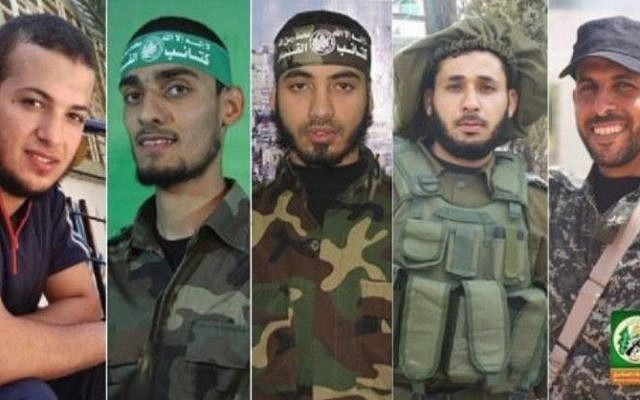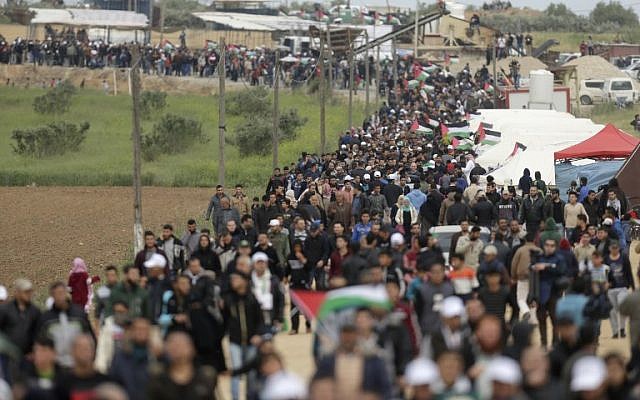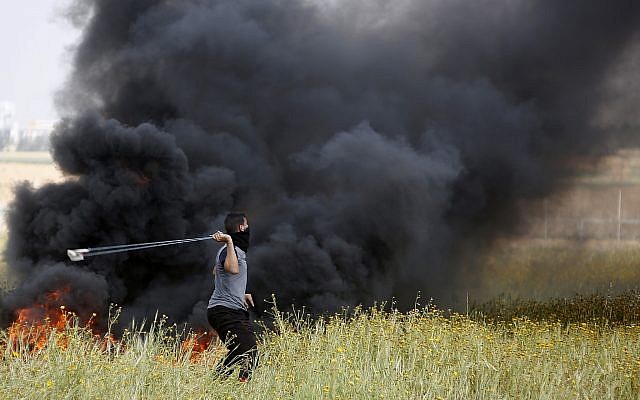Gaza’s ruling terror group claims operatives were taking part in ‘popular events side-by-side with their people’; IDF warns against renewed violence as small protests persist

Palestinian terror group Hamas, which rules the Gaza Strip, acknowledged on Saturday that five members of its military wing, the Izz ad-Din al-Qassam Brigades, were among 16 Gazans said killed on Friday during a massive march and protest along the security fence with Israel.
Hamas claimed those killed were taking part “in popular events side-by-side with their people.”
Thousands attended funerals in Gaza Saturday for 14 of those killed — two were buried on Friday — with mourners holding Palestinian flags and some chanting “revenge” and firing into the air.
“Where are you, Arabs? Where are you, Muslims?” mourners chanted at one funeral, calling on the Arab and Muslim world to intervene. A general strike was being held in both the Gaza Strip and the West Bank.
IDF Spokesman Brig. Gen. Ronen Manelis said on Saturday that all those killed were engaged in violence, adding that Gaza health officials exaggerated the number of those wounded and that several dozen at most were injured by live fire while the rest were merely shaken up by tear gas and other riot dispersal means.
Manelis said on Friday evening that the army had faced “a violent, terrorist demonstration at six points” along the fence. He said the IDF used “pinpoint fire” wherever there were attempts to breach or damage the security fence. “All the fatalities were aged 18-30, several of the fatalities were known to us, and at least two of them were members of Hamas commando forces,” he said.
Tens of thousands of Palestinians marched to Gaza’s border with Israel on Friday in the largest such demonstration in recent memory, calling for Palestinians to be allowed to return to land that their ancestors fled from in Israel’s 1948 War of Independence. It was dubbed the “March of Return.”
The Israeli military said the protesters threw firebombs and rocks at soldiers, rolled burning tires at them, sought to breach or damage the border fence, and in one incident opened fire.

The death toll from Friday’s protest was provided by the Hamas-run Gaza Health Ministry, which also added that some 1,400 Palestinians were injured during the protests, over half by live rounds. Israeli authorities have no way to independently confirm the casualty reports.
Manelis warned Saturday that if violence drags on along the Gaza border, Israel will expand its reaction to strike the terrorists behind it. The military has thus far restricted its response to those trying to breach its border, but if attacks continue it will go after terrorists “in other places, too,” he said.
Manelis reiterated that Israel “will not allow a massive breach of the fence into Israeli territory.”
He said that Hamas and other Gaza terror groups are using protests as a cover for staging attacks. If violence continues, “we will not be able to continue limiting our activity to the fence area and will act against these terror organizations in other places too,” he said.

Hamas is an Islamist terror group that seeks to destroy Israel. It seized control of Gaza from Abbas’s Fatah in a violent coup in 2007.
On Saturday, around 200 demonstrators protested near the border, according to Palestinian media.
The local Shehab news agency reported protests east of Jabaliya and Khan Younis. It said the Israeli military fired at some of the demonstrators, and that two were injured.
Shehab also claimed that the bodies of two demonstrators killed on Friday were in Israeli hands.
The IDF said on Saturday that the bodies belonged to two terrorists who allegedly tried to perpetrate a shooting attack near the fence and were shot and killed, with the remains brought over into Israel, Channel 10 reported.
Friday’s clashes were the deadliest in the Israeli-Palestinian conflict since the 2014 Gaza War. Israeli troops used live ammunition, rubber bullets, and tear gas to keep thousands of Gazans from trying to approach the border fence.

On Friday evening, Gaza’s Hamas leaders called on protesters to retreat from the border area until Saturday.
Protest organizers have said mass marches would continue until May 15, the 70th anniversary of the establishment of the State of Israel. Palestinians mark that date as their “nakba,” or catastrophe, when hundreds of thousands left or were forced to leave during the 1948 War of Independence. The vast majority of Gaza’s two million people are their descendants.
The army has remained on high alert even as the violence appeared to abate Friday evening, amid fears of persisting attacks, including infiltration attempts and rocket fire. Tanks and jets bombed Hamas sites in the early evening, after two Gazans opened fire on troops, the IDF said.
Hadashot news reported Saturday morning that three rockets were launched from the Strip towards Israel overnight following the demonstrations, but that all three fell inside Gaza.
The Palestinian Authority declared Saturday a day of mourning for those killed.
Hamas praised the march and the planned 6-week camp demonstration, with Gaza leader Ismail Haniyeh saying on Friday that the protests marked the beginning of the Palestinians’ return to “all of Palestine.”
“We are here to declare today that our people will not agree to keep the ‘right of return’ only as a slogan,” he said.
Yahya Sinwar, the Hamas leader in Gaza, said in a speech to protesters Friday that “The March of Return… will not stop until we remove this transient border. Friday’s protests, he said, “mark the beginning of a new phase in the Palestinian national struggle on the road to liberation and return [of Palestinian refugees and their descendants to their former homes inside Israel].”
The “March of Return,” Sinwar added, “affirms that our people can’t give up one inch of the land of Palestine.
At previous peace talks, the Palestinians have always demanded, along with sovereignty in the West Bank, Gaza, East Jerusalem,and the Old City, a “right of return” to Israel for Palestinian refugees who left or were forced out of Israel when it was established. The Palestinians demand this right not only for those of the hundreds of thousands of refugees who are still alive — a figure estimated in the low tens of thousands — but also for their descendants, who number in the millions.
No Israeli government would ever be likely to accept this demand, since it would spell the end of Israel as a Jewish-majority state. Israel’s position is that Palestinian refugees and their descendants would become citizens of a Palestinian state at the culmination of the peace process, just as Jews who fled or were forced out of Middle Eastern countries by hostile governments became citizens of Israel.
As reported by The Times of Israel
